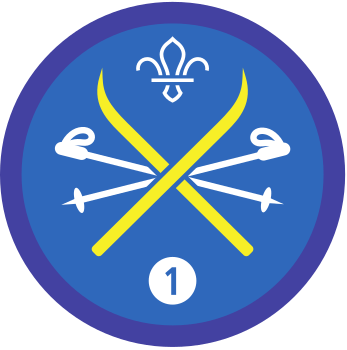Hot or cold
You’ll need
- Basic first aid kit
- Layers (like jumpers, fleeces, hats, scarves, gloves)
Before you begin
- Gather any first aid equipment or supplies that would be suitable for using in a snowsports environment. Things you’re likely to carry include a basic first aid kit, mobile phone, thermals and hot drinks.
- Share with the group the following information about signs, symptoms and treatments for temperature-related conditions.
Always call a healthcare professional or an ambulance as soon as possible for extra help.
Hypothermia: signs
- Shivering
- Cold and pale skin
- Slurred speech
- Fast breathing
- Tiredness
- Confusion
Hypothermia: first aid
- Move them indoors.
- Remove any wet clothing and dry them.
- Wrap them in blankets.
- Give them a warm, non-alcoholic drink, but only if they can swallow normally.
- Give energy food that contains sugar, such as a chocolate bar, but only if they can swallow normally.
Frostbite: signs
- Pins and needles, throbbing/aching
- Cold, numb, white skin
- Hard and frozen skin
- Thawed tissue that becomes red and blistered
Frostbite: first aid
- Move them indoors.
- Don’t put pressure on the affected area.
- Don’t try to quickly warm up the affected area, as this should be done by a professional.
Always call a healthcare professional or an ambulance as soon as possible for extra help.
Heat exhaustion: signs
- A headache
- Dizziness and confusion
- Loss of appetite and feeling sick
- Excessive sweating and pale, clammy skin
- Cramps in the arms, legs and stomach
- Fast breathing or pulse
- Temperature of 38 degrees or above
- Being very thirsty
Heat exhaustion: first aid
- Move them to a cool place.
- Get them to lie down and raise their feet slightly.
- Get them to drink plenty of water. Sports or rehydration drinks are OK.
- Cool their skin – spray or sponge them with cool water and fan them. Cold packs around the armpits or neck help too.
- Stay with them until they’re better.
Heat stroke: signs
- No improvement after 30 minutes rest, cooling off and drinking water
- Not sweating, even when overheated
- Temperature of 40 degrees or higher
- Fast breathing/shortness of breath
- Confusion
- A fit or seizure
- Loss of consciousness and responsiveness
Heat stroke: first aid
- Call emergency services immediately.
- Place the patient in the recovery position if they lose consciousness.
Dehydration: signs
- Feeling thirsty
- Dark yellow and strong-smelling pee
- Feeling dizzy or lightheaded
- Feeling tired
- Dry mouth, lips and eyes
- Peeing little, fewer than four times per day
Dehydration: first aid
- Drink fluids regularly if noticing symptoms
- Stay out of the heat/sun and rest
Run the activity
- Explain that you’ll be looking at some of the effects of extreme temperatures and how to avoid or treat conditions that result from them.
- Split into small groups of four or five. Share with the groups the signs and first aid measures listed above, and check that these have been understood.
- In each group, two people should be nominated to perform first aid. The other members of the group should come up with and roleplay a scenario they might encounter while taking part in snowsports. In each scenario, at least one person should be affected by an extreme temperature-related condition.
- Once each scenario is set up, the first aiders can enter. They should use their knowledge and whatever equipment they have available to work out what’s happened, what the situation is and what they should do to help.
- When each scenario has been attended by the first aiders, groups should discuss the situation together and explore whether the best treatment was used for the condition demonstrated, and whether anything else could’ve been done to help.
Reflection
First aid situations can often feel worrying or stressful, as we’re scared of doing the wrong thing. As first aiders, it’s important to remember that we’re often required to provide comfort and support to anyone who’s been injured or feels unwell while we’re getting them professional help. While first aiders can help to resolve a situation, it’s important that we only do what we can and try to focus on keeping the casualty calm.
So long as we do our best in any situation, new things become less scary and we become able to deal with all kinds of incidents.
Safety
All activities must be safely managed. You must complete a thorough risk assessment and take appropriate steps to reduce risk. Use the safety checklist to help you plan and risk assess your activity. Always get approval for the activity, and have suitable supervision and an InTouch process.
Creating simpler or more complicated scenarios can adjust the difficulty of this activity. Altering the amount of supplies, distance from a safe place or ability to contact others can make this activity more or less difficult.
- First aid situations, even mock ones, can be quite stressful for those involved. Make sure everyone feels comfortable with the activity throughout and stop the activity if anyone becomes distressed.
- This activity allows group members to create their own scenarios to deal with, which can be adapted to suit everyone. Different roles can also be allocated in the scenarios, such as talking to the patient, giving advice or phoning emergency services.
All Scout activities should be inclusive and accessible.
Check out the Emergency Aid Staged Activity Badge for more on developing these skills.
This activity encourages young people to create and explore their own first aid scenarios. This free exploration should be supported throughout, with guidance given when needed. This allows everyone to absorb the new first aid information, as they discuss and explore different situations and how best to deal with them.
